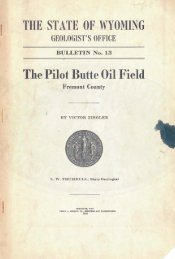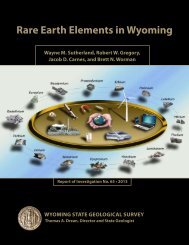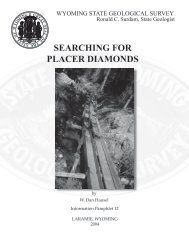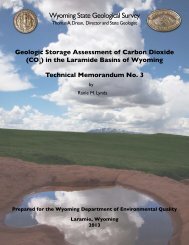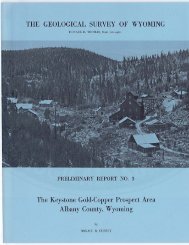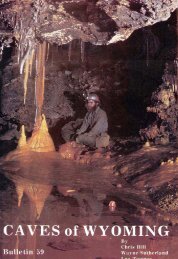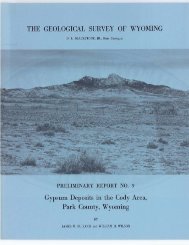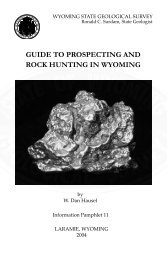The Dinosaurs of Wyoming - Wyoming State Geological Survey ...
The Dinosaurs of Wyoming - Wyoming State Geological Survey ...
The Dinosaurs of Wyoming - Wyoming State Geological Survey ...
Create successful ePaper yourself
Turn your PDF publications into a flip-book with our unique Google optimized e-Paper software.
THE THR E-HORNED DINOSAuRS 99<br />
dinosaurs, yield the information that the huge three-horned<br />
dinosaurs, the Ceratopsia, were exclusively plant feedersstood<br />
upon four stumpy legs and had the hugest bony bonnet<br />
<strong>of</strong> any creatures which ever lived. Dull-witted these hugeheaded<br />
reptiles must have been with a two-pound brain lodged<br />
in a thousand pound head. <strong>The</strong>y didn't need much brain, for<br />
their lives were not complicated. <strong>The</strong>y ate, they slept and<br />
very occasionally they fought-but mostly they slept. Life<br />
was easy in those <strong>Wyoming</strong>-Mesozoic days; food abundant,<br />
and enemies few. <strong>The</strong> carnivorous dinosaurs could have fed<br />
full upon the body <strong>of</strong> a Triceratops, for here was tons and<br />
tons <strong>of</strong> meat and bone-could they have gotten it.<br />
Triceratops was tolerably well provided for <strong>of</strong>fense and<br />
defense. Its huge horned head, with its extensive bony frill<br />
would ward <strong>of</strong>f most attacks, without damage to itself, provided<br />
the enemy could be met head first. Attacks on the<br />
flanks, however, by hungry carnivorous dinosaurs could not·<br />
so easily be repelled. Turning to meet such an attack must<br />
have been somewhat time-consuming. Injuries on head and<br />
body show that. such attacks were made, but we cannot tell<br />
how many such attempts were successful; and then it may be<br />
that the gigantic flesh-eaters were carrion feeders. A herd <strong>of</strong><br />
the Tyrant-K;ng dinosaurs could have caused wide-spread<br />
desolation among the animal life <strong>of</strong> the Upper Cretaceousbut<br />
perhaps they were more sluggish than we anticipate. A<br />
small brain in a fifty-foot animal does not suggest much activity-and<br />
perhaps one full gorge <strong>of</strong> meat would last the King<br />
dinosaur a week or two.<br />
Cope's collection <strong>of</strong> fragmentary dinosaurian material made<br />
in 1875 and 1876, now in the American Museum <strong>of</strong> Natural<br />
History, formed the starting point in our knowledge <strong>of</strong> the<br />
great three-horned dinosaur group, although Cope did not<br />
recognize the existence <strong>of</strong> the sub-order-Ceratopsia. This<br />
was done by Marsh on more complete material secured by<br />
Hatcher. Leidy had much earlier described some dinosaur<br />
teeth collected in this area by the geologist Hayden in 1855.<br />
In the autumn <strong>of</strong> 1888 J. B. Hatcher found a pair <strong>of</strong> very<br />
large horn cores thirty-five miles from Lusk, <strong>Wyoming</strong>, looking<br />
so like the horn cores <strong>of</strong> bison, that Marsh described a new<br />
species <strong>of</strong> bison based on dinosaur horn cores; but at that time<br />
no one had dreamed about the existence <strong>of</strong> the Ceratopsia, as<br />
the group <strong>of</strong> three-horned dinosaurs are called. Early the<br />
next spring, 1889, the discovery <strong>of</strong> the horn cores led Hatcher<br />
to the discovery <strong>of</strong> the great dinosaur-bearing locality in Niobrara<br />
County, <strong>Wyoming</strong>, the collections from which enabled<br />
Marsh to define the three-horned dinosaur group, and here




